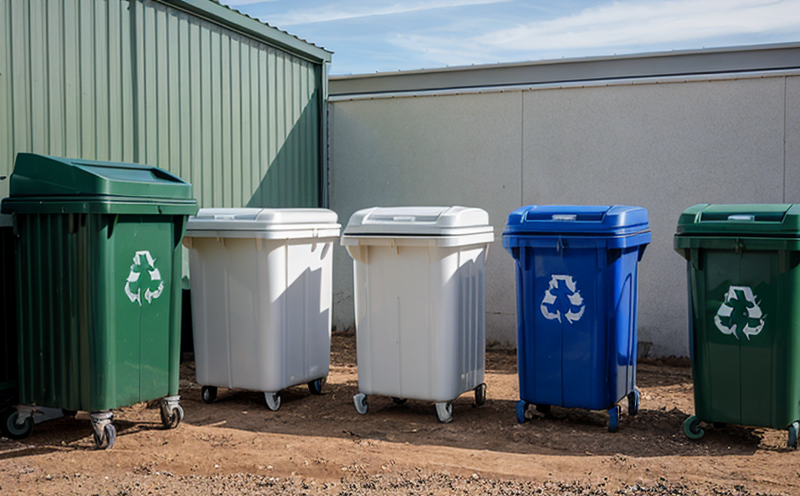ISO 14044 Life Cycle Impact Assessment
The ISO 14044 Life Cycle Impact Assessment (LCIA) is a critical component of sustainability and recycling testing, particularly for the packaging industry. LCIA helps businesses understand the environmental impacts associated with their products throughout their entire lifecycle—from raw material extraction through to end-of-life disposal or recycling.
By employing this standard, organizations can identify areas where improvements are needed and implement strategies that minimize adverse effects on the environment. LCIA provides a robust framework for quantifying these impacts across multiple parameters such as global warming potential (GWP), ozone depletion potential (ODP), acidification, and eutrophication.
The process involves detailed data collection and analysis at various stages of the lifecycle. This includes inventory analysis to determine input and output flows, followed by impact assessment using one or more categories such as climate change, human health, resource depletion, etc. The results are then expressed in terms of environmental indicators which can be used for decision-making purposes.
For packaging manufacturers, LCIA offers invaluable insights into how different design choices might affect overall sustainability goals. For instance, switching from single-use plastic to biodegradable materials could significantly reduce greenhouse gas emissions during the production phase but may increase solid waste generation at the end-of-life stage. Understanding these trade-offs allows companies to make informed decisions that balance competing interests.
Furthermore, LCIA plays a crucial role in meeting regulatory requirements and gaining competitive advantages by demonstrating corporate responsibility towards sustainability issues. Many countries are implementing policies aimed at reducing carbon footprints and promoting circular economy practices. Being able to demonstrate compliance with internationally recognized standards like ISO 14044 can give businesses an edge over competitors who do not prioritize environmental considerations.
Implementing LCIA also contributes positively to brand reputation among consumers increasingly concerned about ecological sustainability. As society shifts towards more eco-conscious consumption patterns, having reliable lifecycle data supports transparent communication with stakeholders about product impacts and fosters trust.
Applied Standards
| Standard Reference | Description |
|---|---|
| ISO 14040:2006 and ISO 14044:2006 | These standards provide guidance on life cycle assessment (LCA) including principles, frameworks, and requirements. They serve as the foundation for all LCA activities. |
| ISO 14044-3:2006 | This part specifies the criteria for life cycle impact assessment (LCIA). It defines methods and approaches to evaluate environmental impacts throughout different stages of a product's lifecycle. |
International Acceptance and Recognition
The ISO 14044 standard has gained widespread acceptance across numerous industries due to its comprehensive approach towards understanding environmental impacts. Many governments, regulatory bodies, and international organizations recommend or require compliance with this standard as part of broader sustainability initiatives.
In the packaging sector specifically, several countries have incorporated LCIA requirements into their national standards and regulations. For example:
- European Union (EU): The EU's Circular Economy Package includes provisions for increased recycling rates and reduced waste generation. LCIA plays a key role in meeting these objectives.
- United States: Various states have adopted laws encouraging businesses to adopt sustainable practices, often including lifecycle assessment methods like those prescribed by ISO 14044.
Beyond governmental mandates, many leading brands and corporations voluntarily commit to using LCIA as part of their corporate social responsibility strategies. This reflects a broader trend among global enterprises seeking ways to contribute positively to environmental conservation efforts.
Competitive Advantage and Market Impact
Incorporating ISO 14044 LCIA into your business strategy offers several tangible benefits that enhance competitiveness within the market:
- Enhanced Reputation: Demonstrating leadership in sustainability can improve brand image and customer loyalty.
- Better Decision-Making: Insights gained from LCIA help refine product development processes, potentially leading to more efficient designs.
- Compliance Assurance: Meeting regulatory expectations reduces legal risks associated with non-compliance penalties.
- Innovation Opportunities: Understanding lifecycle impacts encourages innovation aimed at reducing negative environmental footprints.
Moreover, companies that effectively integrate LCIA into their operations often experience increased demand from environmentally conscious consumers and partners. This translates directly into higher sales volumes and improved profitability.





